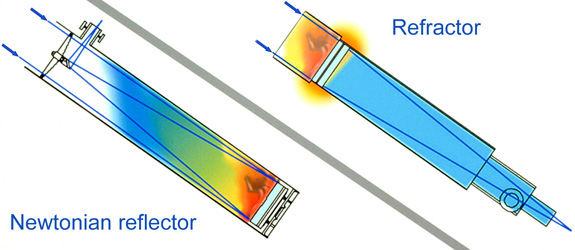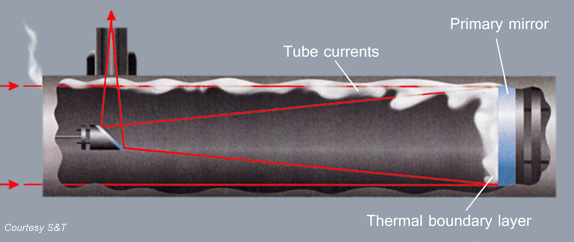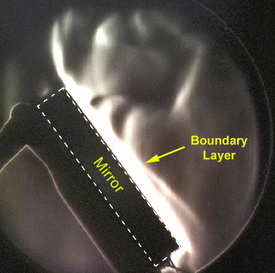
What you need to know when it comes to optimizing your scope’s thermal behavior.
Generations of backyard astronomers have debated why, inch-for-inch, the performance of a high quality refractor usually edges out an equal-quality Newtonian reflector. This disparity is most apparent when viewing low-contrast planetary detail — the images in a good refractors often have a touch more snap to them. Is there some intrinsic shortcoming in the design of the Newtonian reflector that makes this inevitable?
Time and time again, the usual suspects have been rounded up and accused of hindering the reflector’s performance. Scatter in the mirror coatings, mediocre optics, poor baffling, improper collimation, and central obstruction have all been blamed at one time or another. True, any of these can rob your reflector of good views, but if you use a mirror of high quality with good coatings, take care of the baffling and collimation issues, and ensure that the central obstruction is reasonably small, you can still end up with substandard images. Why?
Thermals. Until Bryan Greer’s landmark 2004 S&T articles, few fully appreciated how much thermals affect reflector telescopes. But as Sherlock Homles famously noted, “when you have eliminated the impossible, whatever remains, however improbable, must be the truth.” And the closer you look at the situation, the more probable it seems thermal issues are the #1 killer of Newtonian performance.

Though refractors and reflectors both have thermal issues, those of the refractor tend to be mild and short lived because the objective lens is exposed to the night air. The primary mirror of a Newtonian reflector, however, is shielded by a long tube that inhibits cooldown.
Light-as-Air Lenses
The best known thermal problem goes by the name of “tube currents.” This is warm air that crawls up the inside of a telescope and interferes with light on its way to the eyepiece. But tube currents are only a symptom — the “disease” is really heat radiating from the primary mirror. To understand what you’re up against and where a cure might lie, let’s look at what’s happening inside your scope.

We tend to think of air as invisible, but in actual fact, it behaves like a weak lens, subtly bending light as it passes through. The amount that the light bends depends on the air’s refractive index, and the refractive index depends on the air’s density, which in turn depends on the air’s temperature. In other words, cool (and, therefore, dense) air bends light more than warm (less dense) air. And since the air inside your telescope is not a uniform temperature, light has to pass through what amounts to a whole series of weak and wobbly lenses before it gets to the eyepiece.
What’s worse is that the steepest temperature gradient lies directly in front of the primary mirror. This zone of warm air is referred to as the boundary layer and it does more to harm the image than any other thermal problem. It’s ironic that starlight can traverse a distance of million’s of light years, only to be messed up in the last few feet of its journey.
The Heat Battery

Using a process known as schlieren photography, Ohio telescope maker Bryan Greer captured this image of warm air rising from a cooling telescope mirror.

Inexpensive digital indoor/outdoor thermometers provide a means of monitoring the temperature difference between your telescope’s mirror and the outside air.
You might expect that because there’s only a little warm air inside your scope it should flow out of the tube in a matter of moments to be replaced by cool night time air. That’s what would happen except for one thing: the big hunk of glass at the back of the tube known as the primary mirror. That mass of glass works like a heat battery. All day it gets charged up, and all night long it discharges heat to warm the surrounding air, which then drifts up the tube. So even if you could get all the warm air out of the tube, the mirror will simply replenish the supply. Even open-tube scopes suffer the effects of the thermal boundary layer. Unfortunately, on most nights that heat battery won’t discharge completely — it’ll continue to radiate warmth long after you’ve decided to call it quits and head indoors.
How do you know for sure if your telescope needs help? Thermal problems can look an awful lot like bad atmospheric seeing, but if you haven’t done anything to take care of your scope’s warm mirror, it’s a safe bet that the shimmering views that plague your scope are due at least in large part to thermal issues.
One way to know for sure is to make a trip to your local hardware store to pick up an inexpensive indoor/outdoor digital thermometer. Tape the “outdoor” probe to the back of your scope’s primary mirror. Place the probe directly against the glass and insulate the other side of the probe with a piece of foam before taping it down. Next, attach the display (which houses the “indoor” temperature sensor) to the back end of the scope somewhere. This way you can compare the mirror temperature with the ambient air temperature. Your scope will mostly be free from thermal problems when the mirror is within 3° C (5.4°F) of ambient. Chances are, this is something you’ll rarely see.
All this sounds like bad news, but there is a silver lining on the horizon. Compared with other things you might do to boost your telescope’s performance (such as replacing the primary mirror with a better one, or splurging on enhanced coatings), taking care of thermal issues is relatively simple and inexpensive. All you really have to do is ensure that your mirror is the same temperature as the air outside the telescope. And how you accomplish that is the subject of Part 2.
Did you find this article interesting or helpful? If so, consider using this link the next time you shop at Amazon.com. Better yet, bookmark it for future use. Thanks to Amazon’s associates program, doing so costs you nothing yet helps keep this site up and running. Thanks!
